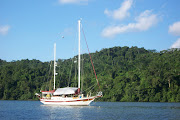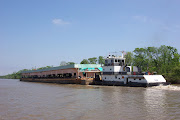After a couple of fun days anchored at Little Crawl Key, it was time to return to Boot Key Harbor. We had made a commitment to give a presentation to cruisers at the Tiki Hut located at the City Marina so we pulled up the anchor and headed back early on Tuesday morning. We really like the opportunity to share our experiences with other boaters and they always go away satisfied that they had just a little more knowledge than they came with. What a difference from our trip east to Little Crawl Key. Hawks Channel was flat calm and we had a pleasant motor back to the Harbor. It was one of those warm sunny days that remind us why we are here this time of year. In about an hour and a half, we were back at a friend's dock and tied up. So far we had tied to our friend's dock, anchored in the harbor and sat on a mooring for a few days. It's nice to try and experience it all. You can view our vessel tracklines for our last 2 cruises at, http://argus.survice.com/vessel_tracking/images/trackline-MarinaLife.html
Safety First
I know that phrase has been seriously over used. But it's the first thing that comes to mind when we're planning a project or preparing for a cruise. Sure there are the usual safety equipment requirements for your boat, but there are many other pieces of safety equipment that for us are cruise specific, depending on when and where we plan to travel. We have an entire category for safety on this blog. That's how serious we are about the issue. In preparing Beach House for our upcoming cruise to the Bahamas and the Great Loop, we had different safety considerations than our recent trips along the Atlantic ICW. Being in close contact to land and having had good VHF and cell phone coverage, our communications equipment was satisfactory at the time. Crossing the Gulf Stream, traveling alone across the Bahamas Banks, anchoring in remote areas or crossing the Gulf of Mexico will mean we need to be able to provide for ourselves without outside help for a period of time. It also means we will need to be able to communicate long range in an emergency.
Curry Hammock State Park
If you plan to use the Little Crawl Key anchorage and visit Curry Hammock State Park, there are a few things you need to know. When landing in the dinghy, please don't tie off to the mangroves. It damages the plants which are protected. If the dinghy has no motor and can be pulled up on the small access beach off the anchorage basin, it's not a problem. If the dinghy has the motor on, the Park requires that you drop an anchor to keep it just off the beach and wade to shore. There are fees to use the facilities that amount to $2.50 per person per day (payable at the park entrance a short walk from where you land your dinghy). The Park entry fee is free for life for disabled veterans. This gives you access to the beach, restrooms, picnic pavilions with charcoal BBQs and several faucets where water jugs can be filled. You can also walk around the park and rent a kayak if you're so inclined. But there's more.
Gunkholing The Florida Keys, Little Crawl Key
The forecast winds and seas had not subsided as we exited Boot Key Harbor via Sisters Creek. Once we were out in Hawks Channel, it was obvious we would have a somewhat boisterous ride for the 10 miles or so to our destination for the day, a snug anchorage at Little Crawl Key (see page 89 of The Great Book Of Anchorages, Norfolk to Key West). With easterly winds and southerly swells, we had a bit of a rolly ride for the next hour and a half once we left the channel markers for Sisters Creek. The multitude of floats from the fish traps also made the short transit a challenge, but it wasn't too uncomfortable. We just needed to keep a sharp eye out and weave through the mine field. The channel entrance into Little Crawl Key requires going past the entrance between the two Keys and picking up the private markers 1 and 2 (Lat 24.44.2813N 080.58.2811W) that lead into the doglegged channel. It's apparent that the markers lead around and behind some very shallow water. The sand bar did knock down the seas quite a bit as we moved towards the entrance. Just past the last set of markers, a shoal extends out from each side of the entrance.
Let The Cruise Begin
It's been four years, tens of thousands of dollars, cuts, bruises and a few curse words that have never been heard by human ears, but we're finally off the dock and underway. Words can not express the feeling as we headed out the channel from Goodland, Florida and watched the marina fade from view. The only thing that kept playing in our minds was "it's finally happening." We had been at Walker's Coon Key Marina for about a month while we finished the generator installation, the Argus system and a few other minor projects. Walker's hauled the boat, painted the bottom and replaced all of the zincs while we were in Maryland for Thanksgiving. When we returned, everything was ready and all we needed to do was to restock our provisions and turn in the rental car. We had dropped off both of our cars at a relative's until our cruise was finished. As we headed toward Gullivan Bay, we encountered a raccoon swimming across the channel and when we had barely reached open water, pods of dolphins began to cavort in our bow and stern wakes. We saw them off and on all the way to Marathon.
Do-It-Yourself Generator Install
For many, many, many years, our trusty Honda 2000 portable generator supplied us with 120-volt electricity when we needed it at anchor. On our sailboat, we used an inverter most of the time and our solar panels and wind generator kept the battery banks topped off. We made the decision early on to install a permanent generator on Beach House for our upcoming cruise to the Bahamas and the Great Loop. We likely won't have the wind conditions needed for a wind generator like we had in the Caribbean, and solar panels are not practical for us right now. We want to be able to run the air conditioner in the Bahamas and the heat in the Great Lakes when we need it, and an inverter would just not do. Generator options for boats are plentiful, and deciding which one would best suit our needs took a lot of research.
Installing Our Garmin GHP 10 Autopilot
After 17 years of sailing on our Mariner 40 Ketch, Sea Trek, we were really used to having an autopilot do most of the steering for us. With Beach House, we did all of the steering ourselves, until now. Both the trip from South Carolina to the Chesapeake and the return to Florida required us to steer every foot of the way. We often mentioned on those trips how much we would like to have had some electronic help. An autopilot has always been on our to-do list, but we decided to wait and install the latest model just before departure time on our upcoming cruise. The time is now.
Subscribe to:
Comments (Atom)













